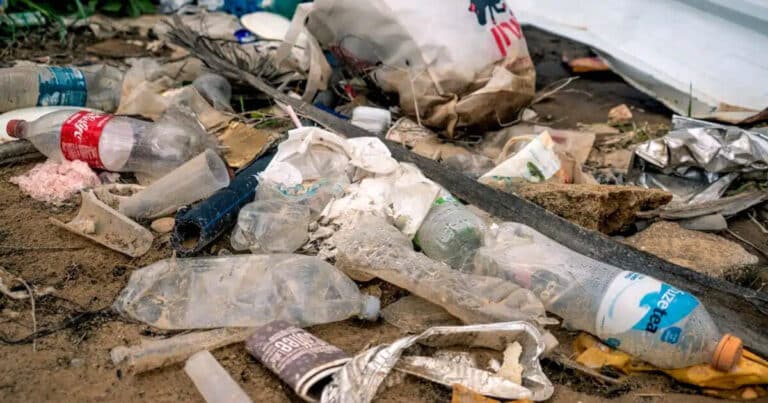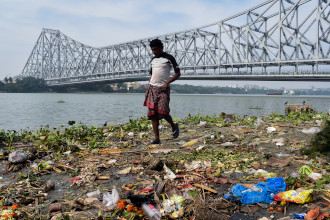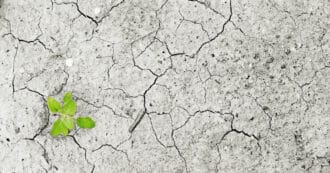By Elisheva Malomet and Deborah Rose – Single-use plastic packaging and bags, drinking bottles and straws, disposable plastic plates, forks, knives and spoons—these are designed and created to be thrown away and destroyed. Throwaway mentality has created a massive environmental problem on Earth from these plastics.
With approximately one trillion nonbiodegradable, single-use plastic bags used and thrown away every year worldwide, it’s no wonder there is increasing urgency for change in how we live, work and deal with this material. Scientific discoveries of microplastics in the deepest ocean, on the highest mountains, in the atmosphere, and even in the human body tell us there is no time to lose in ending our reliance on single-use plastic.
But what can each of us do? How can one person make a difference in regards to plastic waste?
In this post, we will explore the hazards of single-use plastic, critical strategies for reducing our reliance on them, and the impact of interfaith groups on solving this problem which affects everyone on Earth.
The Problems With Single-Use Plastics
Where does all this plastic come from? Made from crude oil, natural gas or coal, each kind of plastic is labeled as one of seven categories—the number inside the three-arrow symbol on products we buy. The numbers let us know the type of plastic and whether it’s recyclable.
What happens with the huge amount of plastic waste that really isn’t recyclable, and in fact is not recycled?
Plastics by the Numbers
The United States Environmental Protection Agency found that plastic containers and packaging contributed to over 14.5 million tons of plastic in 2018. National Geographic found that if this much use continues, by 2050 there will be 13 billion tons of plastic in landfills. That amount is 35,000 times as heavy as New York’s Empire State Building.
Most single-use plastics are numbered in categories 1-5, including drinking bottles, cleaning agent bottles, food packaging, shopping bags and plastic straws. Recycling centers don’t accept many of these because they contain toxic chemicals. The plastic ends up in garbage dumps and landfills. Plastics may then be blown by wind or carried into bodies of water by storm runoff (especially in countries without adequate waste disposal systems).
Plastics Breaking Down into Microplastics
Slowly these plastics break down into smaller and smaller pieces. A plastic bottle takes an estimated 450 years to fully break down. The resulting microplastics remain in our ecosystems, from the deepest ocean to the atmosphere.
This means that while recycling is extremely important, our first steps should be to reduce and reuse. Economically, recycling single-use plastics does not even ensure worthwhile return. Instead of recycling plastic bags we should eliminate them entirely.
Our Throwaway Relationship with Plastics
Single-use plastics damage our relationship with our planet’s resources, people and environment. If we continue to use once and destroy, we will have less and less appreciation for what we own, where we live, and the needs of others.
Plastic is often so cheap and accessible, it seems to make sense to use in place of other materials. We barely register the impact it has on the environment and the more plastic we use, the cheaper it becomes. Then people use it even more, because it’s ”cost free.” The result: a throwaway society with millions of tons of waste and microplastics spread everywhere.
Plastic and Marine Life
Single-use plastics make their way into the wild through littering, haphazard throwaway practices, or movement from landfills. Plastic’s lethal impact is graphically highlighted on beaches and in the ocean, where it kills marine life small and large.
At least 1,000,000 marine creatures—including whales, sea turtles, pelicans, and dolphins—die each year because of plastic in or around the ocean.
Direct and Indirect Threats from Plastic
The frightening reality is that the numbers are probably far greater than the aforementioned figure, as it only accounts for animals that have been found. Plastic poses a direct threat by killing wildlife that get trapped in it or mistake it for food, and an indirect threat from microplastics in the ocean’s food chain.
Reducing Reliance on Single-Use Plastics
To slow and stop the damage, we need to and truly can take steps to remove single-use plastics from our lives. A great way to start is supporting retailers who don’t sell single-use plastic products, and taking an extra look at products we buy. If there is produce wrapped in plastic packaging versus without, opt for loose fruits and veggies (but bag them in nonplastic bags). Buy eggs in biodegradable cartons.
Durable, reusable, and washable alternatives exist to replace single-use plastic water bottles, straws, bags, coffee cups, and cutlery. We can bring reusable bags and containers when we shop or get food at restaurants. Instead of single-use plastics for meals, use ceramic or other reusable dishes and wash them. Many eco-friendly solutions can be found made of materials like metal, glass, paper, bamboo or other sustainable plant and natural fibers.
Initiatives to Reduce Plastic
Find out what your local government is doing to reduce single-use plastics. Local governments and community initiatives can help ban or limit the use of products like plastic bags in stores.
Your locality can make recycling more accessible by providing receptacles for sorting garbage in public places. You can support efforts to incentivize recycling through taxes on products that are not recyclable (e.g., plastics) or subsidies for recycling. If there are no current efforts where you live, you can start a petition, voter initiative or even a local nonprofit, and advocate for change!
Bye Bye Plastic Bags
Bye Bye Plastic Bags NGO is an excellent example of the power of taking initiative and working towards change. This worldwide organization founded by youth has been advocating for plastic bag bans since 2013. Their mission is to educate, find workable solutions, and rid the world of plastic bags.
How Interfaith Groups Work to Reduce Single-Use Plastic
Interfaith groups are uniquely positioned to help educate and influence individuals and entire communities to reduce their own and others’ single-use plastics consumption. These groups’ stances on the environment and sustainable choices, and their public and private partnerships, can have an important impact.
Dozens of rabbis have signed a joint letter calling on their communities to “reduce their use of disposable plastic items as much as possible.” Canadian-based Plastic Bank launched the Social Plastic Interfaith Revolution through the Seasons of Change Faith Webinar, and promotes and provides partnerships engaging interfaith communities in preventing plastic pollution. These collaborations introduce and expand the overlap between religious teachings and a cleaner creation.
What You Can Do on Single Use Plastic
If you are part of a faith-based community, you can start making changes right in your own house of worship or religious schools. Get kids involved too, so they can feel empowered to make change affecting the world they grow up in.
Right now we can reduce our dependence on plastics, be more mindful about our choices for sustainability, and take initiatives in our communities that will protect all life on Earth now and tomorrow.
Further Resource:
Rosas, C. (2020, December 3). Moving Toward a Zero Waste Lifestyle [Blog post]. Retrieved from https://porch.com/advice/moving-toward-zero-waste-lifestyle/
* Featured image source








